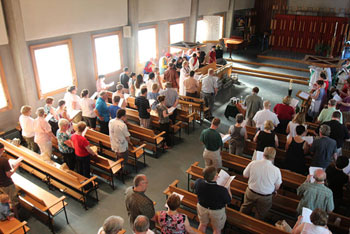The Waterloo Ministries Directory aims to connect Anglican and Lutheran communities that are in some way living out the Waterloo Declaration, the 2001 full communion agreement between the Anglican Church of Canada (ACC) and the Evangelical Lutheran Church in Canada (ELCIC).

The list of 49 ministries, compiled by the Joint Anglican Lutheran Commission (JALC), offers the first national, public overview of what’s happening where. Saskatchewan has the most Waterloo Ministries (16) followed by Alberta (10).
“This directory provides a great opportunity for people to stay in touch,” said Brita Chell, a JALC member and convener of the directory work. “The road to ministry partnerships isn’t always the easiest, but you can lean on others.”
So what counts as a “Waterloo Ministry”? According to the directory, it’s any Anglican-Lutheran ministry that expresses the Waterloo Declaration in one or more of five ways:
- sharing facilities
- sharing programs
- sharing worship
- sharing ordained or rostered ministers
- where a community is served by an ordained or rostered minister of the other full communion partner
Waterloo Ministries may also exist within a larger Ecumenical Shared Ministry. For example, St. Peter’s Ecumenical Church in Slave Lake, Alta., incorporates Lutheran, Anglican, and United traditions.
In short, there’s flexibility—which sometimes means negotiation.
Ms. Chell’s own church. St. Stephen’s and St. Bede’s of Winnipeg, has been a joint Anglican-Lutheran venture since 1970, when they started sharing a building.
“Was it easy? Hardly ever!” wrote Ms. Chell in a recent article for Anglican and Lutheran newspapers.
In their first service together, Anglican and Lutheran members sat on opposite sides of the church. At first there was tension over service times and who got to store their communion elements on the higher cupboard shelf.
The youth groups were the first parts to integrate. After this, members gradually came to appreciate their common heritage, what Ms. Chell calls “a well-developed, liturgical life, rooted in prayer.” Since 2004 they have worshipped as one body.
It takes work and time but the pay-off can be huge.
“I can tell you it’s been blessing upon blessing in our community,” said the Rev. Martha Tatarnic, an Anglican priest at St. David’s Anglican-Lutheran Church in Orillia, Ont., which merged in 2008.
“At this point there’s no sense of some people being Anglican and some people being Lutheran. They certainly respect and honour the denominational ties but more than that there’s a clear understanding of us as followers of Christ and part of the Christian church.”
Full communion blooms through many expressions of both churches. Staff at the national ACC and ELCIC offices are working together to prepare for the Joint Assembly national meeting, July 3 to 7 in Ottawa.
On a regional level, Manitoba has become a new hotspot. The Diocese of Rupert’s Land (ACC) and the Manitoba/Northwestern Ontario Synod (ELCIC) have already produced one joint issue of their publications, in Jan. 2013, and are considering more. A Lutheran pastor serves as dean of an Anglican district and another Lutheran pastor is dean of the Anglican cathedral.
Now the regional offices are setting up a joint office space in Winnipeg, set to open late spring.
The proposed name for the building? Waterloo, of course.
- Download the Waterloo Directory
- Read the Waterloo Declaration
- Learn more about full communion between the ACC and the ELCIC
- Comments or questions? Email Archdeacon Bruce Myers, coordinator for ecumenical relations.
Interested in keeping up-to-date on news, opinion, events and resources from the Anglican Church of Canada? Sign up for our email alerts .
